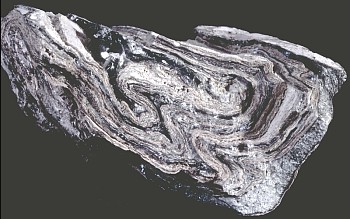rhyolite

Flow banding in rhyolite lava from Mono-Inyo Craters volcanic chain, California (black bands composed of obsidian). Credit: US Geological Survey.
Rhylite is a light-colored, fine-grained, extrusive igneous rock, compositionally the same as granite, with silica (SiO2) content greater than about 68% by weight. Sodium and potassium oxides both can reach about 5% by weight. Common mineral types include quartz, feldspar, and biotite and are often found in a glassy matrix. Rhyolite is erupted at temperatures of 700° to 850°C.
The word rhyolite comes from the Greek word for stream (rhyax) + the suffix lite. Rhyolite was named streaming rock because of its beautiful flow bands, which are made of bubble- and crystal-rich layers that form as the lava flows onto the surface and advances.
Rhyolite can look very different, depending on how it erupts. Explosive eruptions of rhyolite create pumice, which is white and full of bubbles. Effusive eruptions of rhyolite often produce obsidian, which is bubble-free and black. Rhyolite often erupts explosively because its high silica content results in extremely high viscosity (resistance to flow), which hinders degassing. When bubbles form, they can cause the magma to explode, fragmenting the rock into pumice and tiny particles of volcanic ash.


